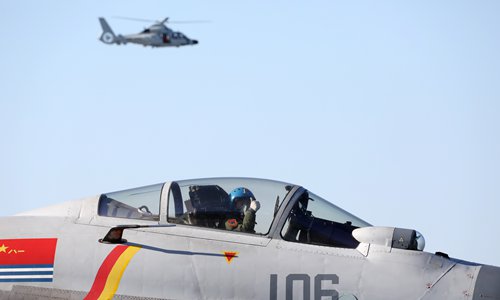Hendrik_2000
Lieutenant General
From Raj 47 . I think he is wrong there are 2 serious accident and one 1 fatal accident at the ground . The other serious accident happened on Liaoning but the pilot survive and he is back at training according to recent press. He show up at the national congress gathering and tell his story
Satellite images reveal China’s state-of-art naval airbase
17 October, 2017

Huangdicun Airbase | Source: Vinayak Bhat
It has 24 aircraft shelters, 3 large hangars possibly for UAVs, one hangar for airborne early warning and control (AEWC) planes, among others.
China’s dream is Chairman Xi Jinping’s vision to achieve superpower status by 2050. To realise this dream, China needs to possess power projection capability much farther than its shores.
China is already building an , which has unprecedented security. The Chinese navy or the People’s Liberation Army Navy (PLAN) plans to build at least six new aircraft carriers to complement the government’s political aims. Its indicates that the six carrier vessels will be in service by 2030.
The Shenyang Aircraft Corporation or SAC, along with 601 Aircraft Design Institute, is working hard to produce enough J-15 aircraft and its variants to match the speed of PLAN. China has produced two batches of 24 J-15A aircraft and has now begun to produce J-15B, which is an improved version.
China’s naval air force (PLANAF), although in existence since 1955, did not have a separate aircraft carrier aviation wing. The need was possibly felt when China’s first aircraft carrier — the Soviet era Kuznetsov-class Riga (renamed Varyag) — reached Dalian from Ukraine in March 2003. The PLANAF needed trained pilots for its carrier aviation wing and a facility to train them.
The need for training of pilots for PLANAF was being alleviated with the Ukrainian offer for NITKA or Ground Aviation Training and Research Complex, to be used at a good rental price. Russia was unwilling to extend the lease for NITKA and Ukraine was looking at China to fill up the place.
The first ski ramp in China was observed in China Flight Test Establishment airport at Xian Yanliang. It was obviously for testing aircraft rather than for training, since it did not have any wire traps.
Construction of specialised airbase
The first airbase with possible ski ramps was noticed in June 2010 at Huangdicun near Xincheng. The airbase construction started in April 2009 and was operational by the end of 2011.
The airbase has two ski ramps and two wire traps with arrestor cables. It has 24 aircraft shelters with one shelter for possible UAV parking, three large hangars possibly for UAVs, one large hangar for airborne early warning and control (AEWC) planes and other administrative facilities.
The airbase was upgraded with two catapults between 2015 and 2016. The first catapult-assisted take off was observed on satellite imagery in October 2016. The two catapults (steam and electromagnetic) suggest that future carrier vessels of the PLAN will have catapult assisted take off but arrested recovery or CATOBAR.
Types of aircraft

Huangdicun Airbase: Aircraft and UAV | Source: Vinayak Bhat
The aircraft usually observed on this airbase are J-15, which are the basic naval aviation backbone developed based on Su-33 of Russian origin. It has features such as missile approach warning system (MAWS), glass cockpit, tail sting and WS-10H engines with improved thrust for ski-ramp take offs.
UAVs and JL-9s have also been observed on this airbase. The presence of JL-9, in addition to J-15 aircraft, on the airbase suggests higher pilot to aircraft ratio.
The UAVs seen on the catapults suggest the future Chinese carrier vessels will have UAVs with CATOBAR (a system used for the launch and recovery of aircraft from the deck of an aircraft carrier) version.
Ski ramps and arrested landing area

Huangdicun: Ski Ramp | Source: Vinayak Bhat
There are two ski ramps on the second runway, half the length of primary runway. Facing opposite directions, these two provide a different take-off experience. The ski ramps have exactly similar size and possibly angle of launch as that of the Liaoning aircraft carrier. The launch positions have been marked on the runway to denote carrier vessel’s shape and exact distance on the carrier deck.

Huangdicun: Arrested Landing Area | Source: Vinayak Bhatt
There are two arrested landing areas marked on the main runway. The arrested landing area in the south has a set of four arrestor cables similar to Liaoning carrier vessel. But the second arrested landing area in the north has only three cables. This indicates possible future carrier vessel’s landing area on a CATOBAR version.
Satellite images reveal China’s state-of-art naval airbase
17 October, 2017

Huangdicun Airbase | Source: Vinayak Bhat
It has 24 aircraft shelters, 3 large hangars possibly for UAVs, one hangar for airborne early warning and control (AEWC) planes, among others.
China’s dream is Chairman Xi Jinping’s vision to achieve superpower status by 2050. To realise this dream, China needs to possess power projection capability much farther than its shores.
China is already building an , which has unprecedented security. The Chinese navy or the People’s Liberation Army Navy (PLAN) plans to build at least six new aircraft carriers to complement the government’s political aims. Its indicates that the six carrier vessels will be in service by 2030.
The Shenyang Aircraft Corporation or SAC, along with 601 Aircraft Design Institute, is working hard to produce enough J-15 aircraft and its variants to match the speed of PLAN. China has produced two batches of 24 J-15A aircraft and has now begun to produce J-15B, which is an improved version.
China’s naval air force (PLANAF), although in existence since 1955, did not have a separate aircraft carrier aviation wing. The need was possibly felt when China’s first aircraft carrier — the Soviet era Kuznetsov-class Riga (renamed Varyag) — reached Dalian from Ukraine in March 2003. The PLANAF needed trained pilots for its carrier aviation wing and a facility to train them.
The need for training of pilots for PLANAF was being alleviated with the Ukrainian offer for NITKA or Ground Aviation Training and Research Complex, to be used at a good rental price. Russia was unwilling to extend the lease for NITKA and Ukraine was looking at China to fill up the place.
The first ski ramp in China was observed in China Flight Test Establishment airport at Xian Yanliang. It was obviously for testing aircraft rather than for training, since it did not have any wire traps.
Construction of specialised airbase
The first airbase with possible ski ramps was noticed in June 2010 at Huangdicun near Xincheng. The airbase construction started in April 2009 and was operational by the end of 2011.
The airbase has two ski ramps and two wire traps with arrestor cables. It has 24 aircraft shelters with one shelter for possible UAV parking, three large hangars possibly for UAVs, one large hangar for airborne early warning and control (AEWC) planes and other administrative facilities.
The airbase was upgraded with two catapults between 2015 and 2016. The first catapult-assisted take off was observed on satellite imagery in October 2016. The two catapults (steam and electromagnetic) suggest that future carrier vessels of the PLAN will have catapult assisted take off but arrested recovery or CATOBAR.
Types of aircraft

Huangdicun Airbase: Aircraft and UAV | Source: Vinayak Bhat
The aircraft usually observed on this airbase are J-15, which are the basic naval aviation backbone developed based on Su-33 of Russian origin. It has features such as missile approach warning system (MAWS), glass cockpit, tail sting and WS-10H engines with improved thrust for ski-ramp take offs.
UAVs and JL-9s have also been observed on this airbase. The presence of JL-9, in addition to J-15 aircraft, on the airbase suggests higher pilot to aircraft ratio.
The UAVs seen on the catapults suggest the future Chinese carrier vessels will have UAVs with CATOBAR (a system used for the launch and recovery of aircraft from the deck of an aircraft carrier) version.
Ski ramps and arrested landing area

Huangdicun: Ski Ramp | Source: Vinayak Bhat
There are two ski ramps on the second runway, half the length of primary runway. Facing opposite directions, these two provide a different take-off experience. The ski ramps have exactly similar size and possibly angle of launch as that of the Liaoning aircraft carrier. The launch positions have been marked on the runway to denote carrier vessel’s shape and exact distance on the carrier deck.

Huangdicun: Arrested Landing Area | Source: Vinayak Bhatt
There are two arrested landing areas marked on the main runway. The arrested landing area in the south has a set of four arrestor cables similar to Liaoning carrier vessel. But the second arrested landing area in the north has only three cables. This indicates possible future carrier vessel’s landing area on a CATOBAR version.









